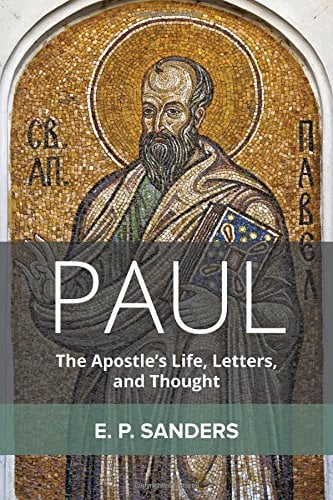CHAPTER NINE— CORINTHIANS PART ONE
p. 225—226– He says he relies heavily on the work of J. Murphy-O’Conner on Corinth. Homer called Corinth ‘wealthy Corinth’ (Iliad 2.570). The business about sacral prostitutes in Corinth is from classical Corinth in the 4th century B.C. but Corinth probably afforded as many opportunities for sexual vice as other major cities especially port cities.
p. 227— the only firm date in the Pauline calendar is A.D. 51 when Gallio was proconsul of Achaia see Acts 18.12-17. The sequence of Acts 17.-18.17 is supported by 1 Thess. 3.1 and partly by its reasonableness, but the second sequence Acts 18.1-20.2 is less accurate. Sanders reconstructs the Corinthian correspondence as follows….
Corinth. A— a letter now lost though 2 Cor. 6.14-7.2 may be a fragment of it
Corinth. B— our 1 Corinthians
Corinth C— 2 Cor. 10-13 terms the painful letter
Corinth D— 2 Cor. 1-9 the letter of relief which refers back to 2 Cor. 10-13.
pp. 228-31– Sanders argues that when 2 Cor. 1-9 was written the crisis was over, and there had been reconciliation with the Corinthians after he had sent the harsh letter [there are however good reasons NOT to see 2 Cor. 10-13 as that letter] What Sanders seems to ignore is that 2 Cor. 10-13 is about false apostles not about the Corinthians per se. His theory (see p. 230) relies on the notion of a super-editor of the Pauline corpus who reshuffled the deck, and incorporated partial letters into a whole. But the only document this seems to apply to is 2 Cor. Here he is relying on the older views of H.D. Betz from 1985— which has since been corrected and refuted. He also sees 2 Cor. 6.14-7.1 as out of place and probably Corinth A letter fragment. (p. 231).
p. 231— He takes on Barrett’s view, whom he calls “a leading conservative scholar of the previous generation” Barrett argues the painful letter carried by Titus was lost. He then argues Titus returned, and Paul wrote 2 Cor. 1-9 as a letter of relief. Later however Paul learned that Titus was wrong, all was not well, and in response Paul wrote 2 Cor. 10-13 which is in part or whole the subsequent stern letter. There he promises a third visit to Corinth, Since Rom. 15.26 says that Achaia contributed to the collection his further visit to Corinth must have been successful. Sanders complains of Barrett p. 233 “If I wish to be conservative, I would try to make sense of what we have rather than creating letters and events that we do not have.” [This is hilarious since Sanders has just made up such a scenario based on no evidence. There is no evidence that 2 Cor. 10-13 was ever part of some separate letter. No manuscript evidence, and had he paid attention to the rhetorical argument for the unity of 2 Corinthians he would not have needed the conjectures he came up with about 2 Cor. 10-13 being the lost letter referred to in 2 Cor. 1-7. Paul says of that letter it was a painful letter, not a harsh letter, a sorrowful letter not a stern rebuke. These descriptors do not suit the content of 2 Cor. 10-13.] Sanders even goes so far as to suggest that 2 Cor. 1-9 now precedes 2 Cor. 10-13 because it is longer, just as Romans precedes other letters because it is longer. [That argument might work if there was any evidence at all that 2 Cor. 1-9 was ever a separate document. There isn’t. We would have to imagine the loss of the end of a letter 2 Cor. 1-9 and the beginning of a letter 2 Cor. 10-13. How convenient for this theory.] He even refers to Martin Luther’s moving of James to the end of the Bible in his translation because he thought them least important.
P 233—“I do not favor a majority of the proposed rearrangements of Paul’s letters, but given the above considerations we really do need 2 Cor. 10-13 before 2 Cor. 1-9.” [The first question the historian should have asked is— is there any material evidence of 2 Cor. 10-13 being in a separate document from 2 Cor. 1-9 and the answer is no. There is no textual basis for this conclusion, and a close reading of the rhetoric of 2 Cor. makes it unnecessary.]
p. 235— He sees Acts 18.8 which refers to many Corinthians being baptized as a contradiction to 1 Cor. 1.14-16 and 2.1 which suggests he only baptized a few. But Paul says 1 Cor. 1 he does not remember who else he baptized!
p. 236— What is the letter referred to in 2 Cor. 7.8— Sanders takes it to be 2 Cor. 10-13. [But a letter that produces sorrow and grief, is not the same thing as a letter that makes people mad and reflects anger. Why not conclude that Paul’s relationship with the Corinthians was tumultuous and it had good times and bad times and sometimes the bad times followed the good repentance of the Corinthians?]
p. 237—He follows the reconstruction of Kirsopp Lake which says 2 Cor. 2.3 refers back to 2 Cor. 13.10 and 2 Cor. 1.23 refers back to 2 Cor. 13.2 and 2 Cor. 2.9 refers back to 2 Cor. 10.6. [Nope. See my Conflict and Community in Corinth].
p. 238— He is right however that Luke smooths over a lot of the tumult in his report of Acts 19.22-20.2. Luke leaves out much of the interim turmoil. But I would note that 1 Clement shows the Corinthians still wrestling and turbulent.













